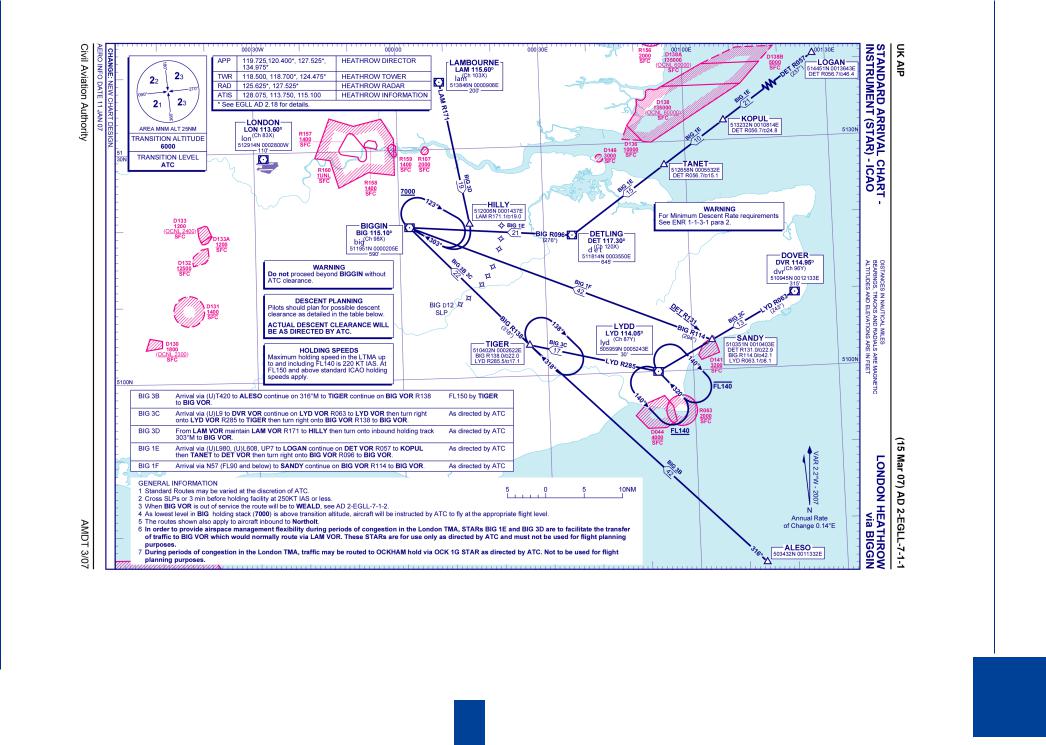
- •Textbook Series
- •Contents
- •1 Definitions
- •Introduction
- •Abbreviations
- •Definitions
- •2 International Agreements and Organizations
- •The Chicago Convention
- •International Law
- •Commercial Considerations
- •Customs and Excise, and Immigration
- •International Obligations of Contracted States
- •Duties of ICAO Member States
- •Status of Annex Components
- •The International Civil Aviation Organization (ICAO)
- •The Organization of ICAO
- •Regional Structure of ICAO
- •Regional Structure and Offices
- •ICAO Publications
- •Other International Agreements
- •The Conventions of Tokyo, the Hague and Montreal
- •The Warsaw Convention
- •The Rome Convention
- •IATA
- •ECAC
- •EASA
- •Eurocontrol
- •World Trade Organization
- •Geneva Convention
- •EU Regulation 261/2004
- •Questions
- •Answers
- •3 Airworthiness of Aircraft
- •Introduction
- •Airworthiness
- •Questions
- •Answers
- •4 Aircraft Nationality and Registration Marks
- •Introduction
- •Nationality and Registration Marks
- •Certification of Registration
- •Aircraft Markings
- •Classification of Aircraft
- •Questions
- •Answers
- •5 Flight Crew Licensing
- •Introduction
- •Definitions
- •General Rules Concerning Licensing
- •Licences and Ratings for Pilots
- •Multi-crew Pilot Licence (MPL)
- •Instrument Rating (Aeroplane) (IR(A))
- •Instructor and Examiner Rating
- •JAR-FCL 3 Medical Requirements
- •Pilot Proficiency
- •EASA Theoretical Knowledge Examinations
- •Questions
- •Answers
- •6 Rules of the Air
- •History
- •Applicability of the Rules of the Air
- •General Rules
- •Visual Flight Rules
- •Instrument Flight Rules
- •Semi-circular Flight Level Rules and RVSM
- •Special VFR
- •Distress and Urgency Signals
- •Restricted, Prohibited or Danger Areas
- •Signals for Aerodrome Traffic
- •Marshalling Signals
- •Flight Deck Signals
- •Questions
- •Answers
- •Instrument Procedures
- •PANS OPS
- •Instrument Departure Procedures
- •Questions
- •Answers
- •8 Approach Procedures
- •Procedure Basics
- •Approach Procedure Design
- •Obstacle Clearance Altitude/Height
- •Operating Minima
- •Descent Gradients
- •Track Reversal and Racetracks
- •Missed Approach Segment and Procedure
- •Published Information
- •RNAV Approach Procedures based on VOR/DME
- •Questions
- •Answers
- •9 Circling Approach
- •Circling Approach
- •Questions
- •Answers
- •10 Holding Procedures
- •Holding Procedures
- •Entry Sectors
- •ATC Considerations
- •Obstacle Clearance
- •Questions
- •Answers
- •11 Altimeter Setting Procedure
- •Altimeter Setting Objectives
- •Transition
- •Phases of Flight
- •Questions
- •Answers
- •12 Parallel or Near-parallel Runway Operation
- •Safety
- •Runway Spacing
- •Questions
- •Answers
- •13 SSR and ACAS
- •Airborne Collision Avoidance System (ACAS)
- •Questions
- •Answers
- •14 Airspace
- •Introduction
- •Control Areas and Zones
- •Classes of Airspace
- •Required Navigation Performance (RNP)
- •Airways and ATS Routes
- •Questions
- •Answers
- •15 Air Traffic Services
- •Introduction
- •Air Traffic Control
- •ATC Clearances
- •Control of Persons and Vehicles at Aerodromes
- •The Flight Information Service
- •The Alerting Service
- •Procedures
- •Questions
- •Answers
- •16 Separation
- •Concept of Separation
- •Vertical Separation
- •Horizontal Separation
- •Radar Separation
- •Procedural Wake Turbulence Separation
- •Radar Wake Turbulence Separation
- •Visual Separation in the Vicinity of Aerodromes
- •Stacking
- •Questions
- •Answers
- •17 Control of Aircraft
- •Procedural ATC
- •Radar Control
- •Radar Identification
- •Radar Service
- •Aerodrome Control
- •Approach Control Service
- •Air Traffic Advisory Service
- •Aircraft Emergencies
- •Questions
- •Answers
- •18 Aeronautical Information Service (AIS)
- •Introduction
- •General
- •The Integrated Aeronautical Information Package
- •The Aeronautical Information Publication (AIP)
- •Notices to Airmen (NOTAM)
- •SNOWTAM
- •ASHTAM
- •Aeronautical Information Circulars (AICs)
- •Pre-flight and Post-flight Information
- •Questions
- •Answers
- •Introduction
- •Aerodrome Reference Code
- •Glossary of Terms
- •Aerodrome Data
- •Runways
- •Taxiways
- •Aprons
- •Questions
- •Answers
- •Requirements
- •Visual Aids for Navigation
- •Runway Markings
- •Taxiway Markings
- •Signs
- •Markers
- •Visual Docking Guidance Systems
- •Questions
- •Answers
- •21 Aerodrome Lighting
- •Aerodrome Lights
- •Approach Lighting Systems
- •Runway Lighting
- •Taxiway Lighting
- •Questions
- •Answers
- •22 Obstacle Marking and Aerodrome Services
- •Introduction
- •Visual Aids for Denoting Obstacles
- •Visual Aids for Denoting Restricted Use Areas
- •Emergency and Other Services
- •Other Aerodrome Services
- •Questions
- •Answers
- •23 Facilitation
- •Entry and Departure of Aircraft
- •Questions
- •Answers
- •24 Search and Rescue
- •Definitions and Abbreviations
- •Establishment and Provision of SAR Service
- •Co-operation between States
- •Operating Procedures
- •Questions
- •Answers
- •25 Security
- •Introduction
- •Objectives
- •Organization
- •Preventative Security Measures
- •Management of Response to Acts of Unlawful Interference
- •Further Security Information
- •Questions
- •Answers
- •26 Aircraft Accident and Incident Investigation
- •Introduction
- •Objective of Investigation
- •Investigations
- •Serious Incidents
- •EU Considerations
- •Questions
- •Answers
- •27 Revision Questions
- •Revision Questions
- •Answers
- •EASA Specimen Examination
- •Answers to Specimen EASA Examination
- •28 Addendum – EASA Part-FCL & Part-MED
- •Chapter Five. Flight Crew Licensing
- •European Aviation Safety Agency (EASA)
- •Licences
- •Ratings
- •Certificates
- •EASA Part-MED
- •29 Index

16 Separation
Stacking
16.52 Approach Sequence. Where more than one aircraft is arriving it is normal for the aircraft at the lowest altitude to land first. Where necessary, a holding pattern will be established for ‘stacking’ of aircraft waiting to start the approach. Under certain circumstances, a later arrival will be given priority over earlier arrivals. Such circumstances are:
|
• |
Where an aircraft is compelled to land because of factors affecting the safety of the |
|
|
|
aeroplane or the occupants. In this case, the PIC of the aircraft involved will be expected to |
|
|
|
declare an emergency using either “MAYDAY” or “PAN PAN” procedures; |
|
|
• |
Hospital aircraft or aircraft carrying sick or seriously injured people. International hospital |
|
|
|
flights will prefix initial RTF with “PAN PAN MEDICAL”; |
|
|
• Aircraft engaged in SAR operations; |
||
|
• Other aircraft as may be determined by the authority. |
||
|
16.53 Procedure. It is normal for ‘stacks’ to be established on the radio navigation beacons |
||
|
serving as the IAF for the instrument procedures to be used. The vertical size of the stack may |
||
|
be limited by airspace considerations and when full, ‘overspill’ stacks would be established on |
||
|
remote beacons. Arriving aircraft will be cleared into the stack at the lowest available level. |
||
|
Normal holding pattern joining procedures are used. Aircraft will be cleared to commence the |
||
|
instrument procedure from the lowest holding altitude (the bottom of the stack) using timed |
||
|
arrival procedures. If a pilot states his/her intention to continue holding awaiting a weather |
||
|
improvement when other pilots wish to make an instrument approach, the holding pilot will be |
||
|
instructed to take up another holding pattern or directed to rejoin the hold at the top. If a pilot |
||
16 |
|||
elects to attempt an instrument approach when others remain in the hold, an unsuccessful |
|||
|
|||
Separation |
approach would result in the aircraft being directed back into the stack at the top. |
||
|
|
||
16.54 Expected Approach Time (EAT). When an aircraft enters a stack the controlling ATCO will pass an EAT which must be acknowledged by the pilot. This will be the time that the pilot can expect to commence the instrument approach. Initially the EAT will not be less than 30 minutes after the time of entry. If it is expected that the aircraft will not be held for more than 20 minutes, the pilot will be informed “no delay expected”. As the approach sequence progresses, if necessary the EAT will be revised by 5 minute intervals, passed to the pilot and acknowledged.
16.55 En Route Holding. It is often preferred to hold an aircraft en route at cruising altitude, rather than to progress the flight to the terminal stage and hold at low level with high fuel burn rates. Where delays are known to exist and aircraft are held en route, credit will be given for time spent holding en route by inserting the aircraft into the approach sequence ahead of other aircraft so that the aircraft that has held en route is not penalized.
Should an en route aircraft be instructed by ATC to take up a hold while en route, this may necessitate basing the hold over a non-standard holding point (a town, a point of latitude and longitude, a significant point along the route) – i.e. not over an authorized navigational aid over which a recognized hold is based. In this case, unless otherwise instructed, the aircraft should take up a right-hand hold.
312

Figure 16.24 The STAR for LHR via the Biggin VOR showing the Biggin stack with LHA at 7000 ft and the alternative stacks at LYDD
313
Separation 16
16 Separation

|
16 |
|
Questions |
|
||
Questions |
|
|||||
|
|
|
|
|
||
|
|
|
|
1. |
What types of separation does ATC apply? |
|
|
|
|
|
|
a. |
Horizontal, longitudinal and timing. |
|
|
|
|
|
b. |
Horizontal, vertical and longitudinal. |
|
|
|
|
|
c. |
Horizontal, vertical and composite. |
|
|
|
|
|
d. |
Horizontal, vertical and lateral. |
|
|
|
|
2. |
If you want to descend through the level of another aircraft on the same track, the |
|
|
|
|
|
|
minimum separation is: |
|
|
|
|
|
|
a. |
20 minutes. |
|
|
|
|
|
b. |
10 minutes. |
|
|
|
|
|
c. |
5 minutes. |
|
|
|
|
|
d. |
15 minutes. |
|
|
|
|
3. |
What is the minimum longitudinal separation standard required for RNAV routes? |
|
|
|
|
|
|
a. |
80 NM. |
|
|
|
|
|
b. |
60 NM. |
|
|
|
|
|
c. |
50 NM. |
|
|
|
|
|
d. |
20 NM. |
|
|
|
|
4. |
What is the vertical separation minimum below FL290? |
|
|
|
|
|
|
a. |
500 ft. |
|
|
|
|
|
b. |
1000 ft. |
16 |
|
|
|
c. |
2000 ft. |
|
|
|
|
d. |
It depends whether or not RVSM is applied. |
||
|
|
|
|
|
||
Questions |
5. |
What is the minimum vertical separation between IFR aircraft flying in the same |
||||
|
|
|
|
|||
|
|
|
|
|
direction above FL290 in non-RVSM airspace? |
|
|
|
|
|
|
a. |
1000 ft. |
|
|
|
|
|
b. |
500 ft. |
|
|
|
|
|
c. |
2000 ft. |
|
|
|
|
|
d. |
4000 ft. |
|
|
|
|
6. |
When can one aircraft pass through the level of another aircraft which is flying |
|
|
|
|
|
|
along an ATS route, in VMC maintaining own separation? |
|
|
|
|
|
|
a. |
If the pilot requests and the state approves. |
|
|
|
|
|
b. |
If the pilot requests and it is day time. |
|
|
|
|
|
c. |
If the pilot requests during day or night. |
|
|
|
|
|
d. |
Irrelevant - the manoeuvre is not permitted. |
|
|
|
|
7. |
What is the separation based on RNAV when RNP is specified? |
|
|
|
|
|
|
a. |
80 NM. |
|
|
|
|
|
b. |
50 NM. |
|
|
|
|
|
c. |
80 or 50 dependent upon the RNP type. |
|
|
|
|
|
d. |
15 minutes. |
314

|
|
Questions |
|
16 |
|
||
8. |
If two aircraft are using the same VOR for track separation, what distance must the |
||||||
|
|
|
|
||||
|
aircraft be from the VOR before one of the two may commence a climb or descent? |
|
|
|
|
||
|
a. |
5 NM. |
|
|
|
|
|
|
b. |
10 NM. |
|
|
|
|
|
|
c. |
15 NM. |
|
|
|
|
|
|
d. |
20 NM. |
|
|
|
|
|
9. |
Whilst under IFR in VMC you decide to maintain your own separation to descend |
|
|
|
|
||
|
through the level of another aircraft. What is required? |
|
|
|
|
||
|
a. |
During day you must request clearance and with ATC authority approval. |
|
|
|
|
|
|
b. |
You must request clearance and the ATC authority must approve, during day |
|
|
|
|
|
|
|
or night. |
|
|
|
|
|
|
c. |
You only need to request approval for the manoeuvre. |
|
|
|
|
|
|
d. |
In CAS the manoeuvre is illegal. |
|
|
|
|
|
10. |
Two aircraft are on the same track at the same level and are using simultaneous |
|
|
|
|
||
|
DME fixes from the same on track DME station. What is the minimum longitudinal |
|
|
|
|
||
|
separation applied? |
|
|
|
|
||
|
a. |
10 NM. |
|
|
|
|
|
|
b. |
5 NM. |
|
|
|
|
|
|
c. |
20 NM. |
|
|
|
|
|
|
d. |
15 NM. |
|
|
|
|
|
11. |
What is the separation standard between aircraft at the same altitude when using |
|
|
|
|
||
|
DME to determine range from a beacon? |
|
|
|
|
||
|
|
|
|
|
|||
|
a. |
10 NM where the first aircraft speed is 40 kt faster than the second. |
|
16 |
|
||
|
b. |
10 NM where the first aircraft speed is 20 kt faster than the second. |
|
|
|
|
|
|
|
|
Questions |
||||
|
c. |
20 NM where the first aircraft speed is 40 kt faster than the second. |
|
|
|||
|
|
|
|
|
|||
|
d. |
20 NM where the first aircraft speed is 20 kt faster than the second. |
|
|
|
|
|
12. |
Two aircraft are using the Mach number technique (both at same Mach number or |
|
|
|
|
||
|
first faster than second) for same track separation. If using an RNAV track, what |
|
|
|
|
||
|
would be the standard separation in lieu of time? |
|
|
|
|
||
|
a. |
80 NM. |
|
|
|
|
|
|
b. |
60 NM. |
|
|
|
|
|
|
c. |
50 NM. |
|
|
|
|
|
|
d. |
25 NM. |
|
|
|
|
|
13. |
When can a controlled flight be given permission to climb/descend maintaining |
|
|
|
|
||
|
own separation in VMC? |
|
|
|
|
||
|
a. |
When directed by ATC. |
|
|
|
|
|
|
b. |
When requested by the pilot and the ATC approves. |
|
|
|
|
|
|
c. |
When there is no conflicting traffic. |
|
|
|
|
|
|
d. |
When approved by the operator. |
|
|
|
|
|
14. |
What is essential traffic? |
|
|
|
|
||
|
a. |
Flights engaged in priority flights i.e. VIP, hospital or police flights. |
|
|
|
|
|
|
b. |
Any conflicting traffic. |
|
|
|
|
|
|
c. |
Traffic which should be separated but which isn’t. |
|
|
|
|
|
|
d. |
Unidentified traffic on radar. |
|
|
|
|
|
315

16 Questions
15. |
When is essential traffic information passed to an aircraft? |
||
|
|
a. |
Before a take-off clearance is issued. |
|
|
b. |
Where traffic constitutes essential traffic to another controlled flight. |
|
|
c. |
When the separation minima cannot be maintained. |
|
|
d. |
When a pilot requests permission to descend or climb maintaining own |
|
|
|
separation. |
16. |
What is the divergence angle that must be maintained from overhead an NDB |
||
|
|
to a range of 15 NM to allow one aircraft to climb/descend through the level of |
|
|
|
another? |
|
|
|
a. |
15°. |
|
|
b. |
30°. |
|
|
c. |
45°. |
|
|
d. |
60°. |
17. |
The longitudinal separation minimum, based on time between two aircraft at the |
||
|
|
same altitude, for which navigation aids can give a frequent determination of |
|
|
|
position and speed and when the proceeding aircraft has a true airspeed of at least |
|
|
|
40 kt higher than the following aircraft, is: |
|
|
|
a. |
5 minutes. |
|
|
b. |
6 minutes. |
|
|
c. |
10 minutes. |
|
|
d. |
3 minutes. |
18. |
A separation minimum based on “RNAV” distance can be used at the moment the |
||
|
|
level is being passed, assuming that every aircraft reports its distance to or from |
|
16 |
|
||
|
the same “on-track” waypoint. The minimum is: |
||
|
|
|
|
Questions |
a. |
60 NM. |
|
|
|
||
|
|
b. |
80 NM. |
|
|
c. |
50 NM. |
|
|
d. |
20 NM. |
19. |
With the Mach number technique applied what is the longitudinal standard |
||
|
|
separation between two aircraft of which the preceding aircraft is M 0.04 faster |
|
|
|
than the following aircraft? |
|
|
|
a. |
10 minutes. |
|
|
b. |
9 minutes. |
|
|
c. |
8 minutes. |
|
|
d. |
7 minutes. |
20. |
What is the divergence angle that must be maintained from overhead a VOR |
||
|
|
to a range of 15 NM to allow one aircraft to climb/descend through the level of |
|
|
|
another? |
|
|
|
a. |
15°. |
|
|
b. |
30°. |
|
|
c. |
45°. |
|
|
d. |
60°. |
316

|
|
Questions |
|
16 |
|
||
21. |
The longitudinal separation minimum, based on time between two aircraft at the |
||||||
|
|
|
|
||||
|
same altitude, for which navigation aids can give a frequent determination of |
|
|
|
|
||
|
position and speed and when both aircraft have updated navigation data, can be |
|
|
|
|
||
|
reduced to 5 minutes if: |
|
|
|
|
||
|
a. |
the first aircraft has updated the navigation data within the last 10 minutes. |
|
|
|
|
|
|
b. |
both aircraft have updated the navigation data within the last 10 minutes. |
|
|
|
|
|
|
c. |
the second aircraft is updating navigation data at the time. |
|
|
|
|
|
|
d. |
the second aircraft has updated the navigation data within the last 10 |
|
|
|
|
|
|
|
minutes. |
|
|
|
|
|
22. |
Two aircraft are on crossing tracks at the same level where the navigation aids |
|
|
|
|
||
|
do not permit frequent update of speed and position. What is the minimum |
|
|
|
|
||
|
separation applied? |
|
|
|
|
||
|
a. |
3 minutes. |
|
|
|
|
|
|
b. |
5 minutes. |
|
|
|
|
|
|
c. |
10 minutes. |
|
|
|
|
|
|
d. |
15 minutes. |
|
|
|
|
|
23. |
What is the required track divergence between the departure track and the missed |
|
|
|
|
||
|
approach track for parallel runway operations? |
|
|
|
|
||
|
a. |
15°. |
|
|
|
|
|
|
b. |
30°. |
|
|
|
|
|
|
c. |
45°. |
|
|
|
|
|
|
d. |
60°. |
|
|
|
|
|
24. |
Longitudinal separation based on time for aircraft at the same level when |
|
|
|
|
||
|
|
16 |
|
||||
|
navigation aids permit frequent determination of speed and position and where |
|
|
||||
|
the preceding aircraft is maintaining TAS 20 kt faster than the succeeding aircraft, |
|
|
|
|
||
|
|
|
Questions |
||||
|
is: |
|
|
|
|||
|
|
|
|
|
|
||
|
a. |
10 minutes. |
|
|
|
|
|
|
b. |
2 minutes. |
|
|
|
|
|
|
c. |
5 minutes. |
|
|
|
|
|
|
d. |
3 minutes. |
|
|
|
|
|
25. |
The reduced radar separation provided to aircraft established on the same localizer |
|
|
|
|
||
|
course is: |
|
|
|
|
||
|
a. |
2 NM. |
|
|
|
|
|
|
b. |
5 NM. |
|
|
|
|
|
|
c. |
3 NM. |
|
|
|
|
|
|
d. |
2.5 NM. |
|
|
|
|
|
26. |
Longitudinal separation based on time for aircraft at the same level when |
|
|
|
|
||
|
navigation aids permit frequent determination of speed and position is: |
|
|
|
|
||
|
a. |
10 minutes. |
|
|
|
|
|
|
b. |
2 minutes. |
|
|
|
|
|
|
c. |
5 minutes. |
|
|
|
|
|
|
d. |
3 minutes. |
|
|
|
|
|
317

16 Questions
27. |
If an aircraft is making a ‘straight-in’ approach a departing aircraft may take off in |
||
|
|
any direction: |
|
|
|
a. |
until 2 minutes before the arriving aircraft is estimated to be over the |
|
|
|
threshold of the instrument runway. |
|
|
b. |
until 10 minutes before the arriving aircraft is estimated to be over the |
|
|
|
threshold of the instrument runway. |
|
|
c. |
until 5 minutes before the arriving aircraft is estimated to be over the |
|
|
|
threshold of the instrument runway. |
|
|
d. |
until 3 minutes before the arriving aircraft is estimated to be over the |
|
|
|
threshold of the instrument runway. |
28. |
Unless otherwise prescribed by the appropriate ATS authority, the horizontal radar |
||
|
|
separation minimum is: |
|
|
|
a. |
2.5 NM. |
|
|
b. |
5 NM. |
|
|
c. |
3 NM. |
|
|
d. |
2 NM. |
29. |
Separation between departing aircraft may be reduced to 2 minutes when: |
||
|
|
a. |
the preceding aircraft is 30 kt or more faster than the succeeding aircraft. |
|
|
b. |
the preceding aircraft is 20 kt or more faster than the succeeding aircraft. |
|
|
c. |
the preceding aircraft is 10 kt or more faster than the succeeding aircraft. |
|
|
d. |
the preceding aircraft is 40 kt or more faster than the succeeding aircraft. |
30. |
To meet wake turbulence separation criteria for aircraft using timed approaches, |
||
|
|
what is the minimum applied to aircraft landing behind a heavy or medium |
|
16 |
|
||
|
aircraft? |
||
|
|
|
|
Questions |
a. |
Medium behind heavy = 2 minutes. |
|
|
|
||
|
|
b. |
Medium behind medium = 2 minutes. |
|
|
c. |
Light behind medium = 4 minutes. |
|
|
d. |
Medium behind heavy = 3 minutes. |
31. |
Track separation between aircraft using the same DR fix shall be applied requiring |
||
|
|
the aircraft to fly: |
|
|
|
a. |
at least 45° separated at a distance of 15 NM or more from the fix. |
|
|
b. |
at least 30° separated at a distance of 15 km or more from the fix. |
|
|
c. |
at least 30° separated at a distance of 15 NM or more from the fix. |
|
|
d. |
at least 45° separated at a distance of 15 km or more from the fix. |
32. |
A separation minimum shall be applied between a light or medium aircraft and |
||
|
|
a heavy aircraft, and between a light and a medium aircraft, when the heavier |
|
|
|
aircraft is making a low or missed approach and the lighter aircraft is landing on the |
|
|
|
same runway in the opposite direction, or on a parallel opposite direction runway |
|
|
|
separated by: |
|
|
|
a. |
730 m. |
|
|
b. |
Less than 760 m. |
|
|
c. |
760 m. |
|
|
d. |
Less than 730 m. |
318

|
|
Questions |
|
16 |
|
||
33. |
What would be the minimum distance applied in an approach sequence between a |
||||||
|
|
|
|
||||
|
heavy aircraft followed by a light aircraft? |
|
|
|
|
||
|
(Note: It is assumed that this question is applicable to radar wake turbulence and |
|
|
|
|
||
|
assumes that the following aircraft is at the same level as the preceding aircraft.) |
|
|
|
|
||
|
a. |
6 NM. |
|
|
|
|
|
|
b. |
3 NM. |
|
|
|
|
|
|
c. |
4 NM. |
|
|
|
|
|
|
d. |
5 NM. |
|
|
|
|
|
34. |
What is the minimum vertical separation between IFR aircraft flying below FL290? |
|
|
|
|
||
|
a. |
500 ft. |
|
|
|
|
|
|
b. |
1500 ft. |
|
|
|
|
|
|
c. |
2000 ft. |
|
|
|
|
|
|
d. |
1000 ft. |
|
|
|
|
|
35. |
What is the minimum radar separation applied between aircraft on adjacent |
|
|
|
|
||
|
localizer courses during simultaneous parallel approaches mode 2 - dependent? |
|
|
|
|
||
|
a. |
2 NM. |
|
|
|
|
|
|
b. |
2.5 NM. |
|
|
|
|
|
|
c. |
3 NM. |
|
|
|
|
|
|
d. |
5 NM. |
|
|
|
|
|
36. |
When one aircraft will pass through the level of another aircraft on the same track |
|
|
|
|
||
|
where navigation aids permit frequent determination of speed and position, the |
|
|
|
|
||
|
minimum longitudinal separation provided is: |
|
|
|
|
||
|
|
|
16 |
|
|||
|
|
|
|
|
|||
|
a. |
5 minutes at the time the level is crossed. |
|
|
|
|
|
|
|
|
Questions |
||||
|
b. |
10 minutes at the time the level is crossed. |
|
|
|||
|
|
|
|
|
|||
|
c. |
15 minutes at the time the level is crossed. |
|
|
|
|
|
|
d. |
20 minutes at the time the level is crossed. |
|
|
|
|
|
37. |
In order to meet the wake turbulence separation criteria, what separation should |
|
|
|
|
||
|
be applied when a medium aircraft is taking off behind a heavy and both are using |
|
|
|
|
||
|
the same runway? |
|
|
|
|
||
|
a. |
2 minutes. |
|
|
|
|
|
|
b. |
3 minutes. |
|
|
|
|
|
|
c. |
4 minutes. |
|
|
|
|
|
|
d. |
1 minute. |
|
|
|
|
|
38. |
What is the reduced radar separation applied between aircraft on the same ILS |
|
|
|
|
||
|
localiser course within 10 NM of touchdown? |
|
|
|
|
||
|
a. |
5 NM. |
|
|
|
|
|
|
b. |
2.5 NM. |
|
|
|
|
|
|
c. |
3 NM. |
|
|
|
|
|
|
d. |
2 NM. |
|
|
|
|
|
319

16 Questions
39. |
Longitudinal separation based on time for aircraft at the same level when |
|||
|
|
navigation aids permit frequent determination of speed and position and the |
||
|
|
preceding aircraft is maintaining a TAS 40 kt faster than the succeeding aircraft is: |
||
|
|
a. |
10 minutes. |
|
|
|
b. |
15 minutes. |
|
|
|
c. |
5 minutes. |
|
|
|
d. |
3 minutes. |
|
40. |
RNAV distance based separation may be used at the time the level is crossed, |
|||
|
|
provided that each aircraft reports its distance to or from the same ‘on track’ |
||
|
|
waypoint. The minimum is: |
||
|
|
a. |
60 NM. |
|
|
|
b. |
50 NM. |
|
|
|
c. |
20 NM. |
|
|
|
d. |
80 NM. |
|
41. |
The normal radar separation standard may be reduced, when radar capabilities |
|||
|
|
permit, to: |
||
|
|
a. |
3 NM. |
|
|
|
b. |
5 NM. |
|
|
|
c. |
1.5 NM. |
|
|
|
d. |
1 NM. |
|
42. |
What wake turbulence separation is applied when a light aircraft is taking off |
|||
|
|
behind a medium aircraft? |
||
|
|
|
|
|
16 |
|
a. |
3 minutes. |
|
|
|
b. |
1 minute. |
|
Questions |
||||
c. |
2 minutes. |
|||
|
|
|||
|
|
d. |
5 minutes. |
|
43. |
One minute separation may be used between departing aircraft if the tracks to be |
|||
|
|
flown diverge by at least: |
||
|
|
a. |
25° immediately after take-off. |
|
|
|
b. |
45° immediately after take-off. |
|
|
|
c. |
30° immediately after take-off. |
|
|
|
d. |
15° immediately after take-off. |
|
44. |
The separation method whereby the vertical and horizontal separation may be |
|||
|
|
reduced to a minimum of half the standard is called: |
||
|
|
a. |
composite separation. |
|
|
|
b. |
combined separation. |
|
|
|
c. |
reduced separation. |
|
|
|
d. |
essential separation. |
|
320

Questions 16
45.The longitudinal separation minima based on distance using DME from ‘on track’ DME stations is:
a.10 NM.
b.5 NM.
c.20 NM when the leading aircraft maintains a TAS 20 kt faster than the succeeding aircraft.
d.20 NM.
46.The longitudinal separation minima based on distance using DME where each aircraft uses ‘on track’ DME stations is:
a.10 NM when the leading aircraft maintains a TAS 20 kt faster than the succeeding aircraft.
b.10 NM when the leading aircraft maintains a TAS 40 kt faster than the succeeding aircraft.
c.20 NM when the leading aircraft maintains a TAS 10 kt faster than the succeeding aircraft.
d.10 NM when the leading aircraft maintains a TAS 10 kt faster than the succeeding aircraft.
47.Aircraft flying reciprocal tracks may be cleared to climb and descend through the level of the other aircraft provided the manoeuvre does not commence until:
a.5 minutes after the aircraft are assumed to have passed each other.
b.10 minutes after the aircraft are assumed to have passed each other.
c.15 minutes after the aircraft are assumed to have passed each other.
d.20 minutes after the aircraft are assumed to have passed each other.
48.An aircraft will not be given clearance to take off until the preceding aircraft has:
a.reported airborne and climbed to 500 ft.
b.left the aerodrome traffic zone.
c.crossed the upwind end of the runway or made a turn away from the runway.
d.reported ‘downwind’.
49.A departing aircraft will not be permitted to take off when arriving instrument traffic has:
a.started the procedure turn.
b.passed a point 10 minutes from the threshold of the instrument runway.
c.reported “field in sight”.
d.reported “long final”.
50.Wake turbulence separation is:
a.applicable at all times.
b.applicable only between aircraft of different wake turbulence categories.
c.applicable only between aircraft at the same level or where the succeeding aircraft is less than 1000 ft below the preceding aircraft.
d.not applicable to parallel runway operations.
Questions 16
321
